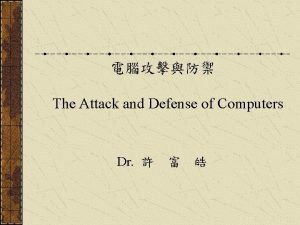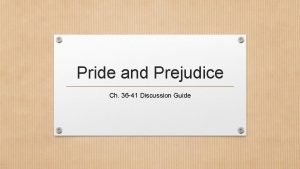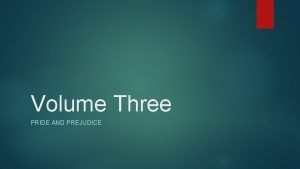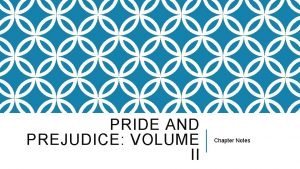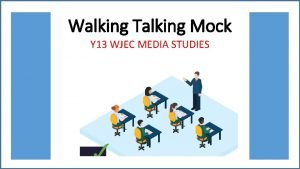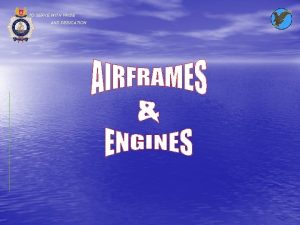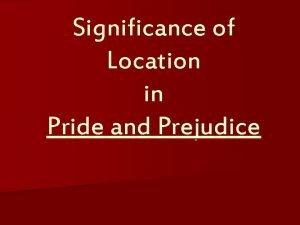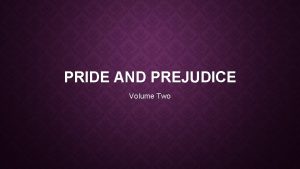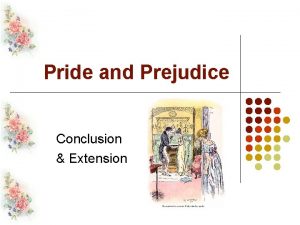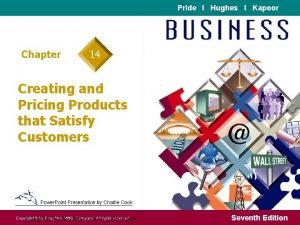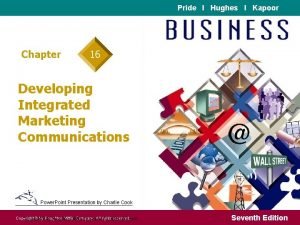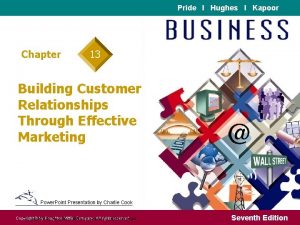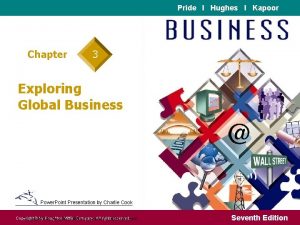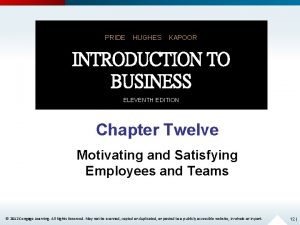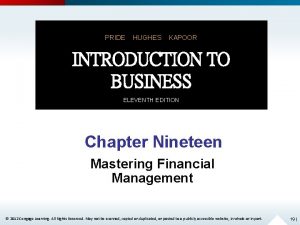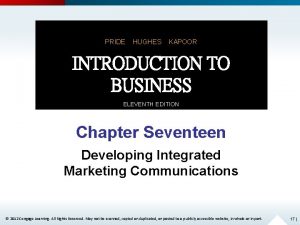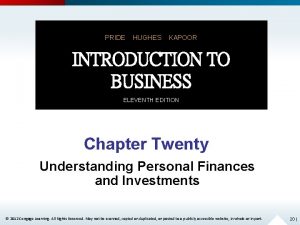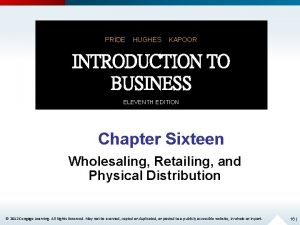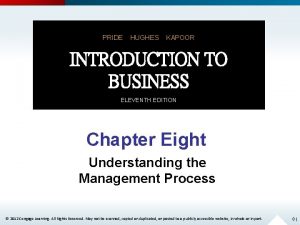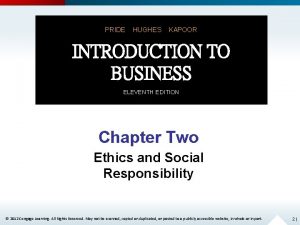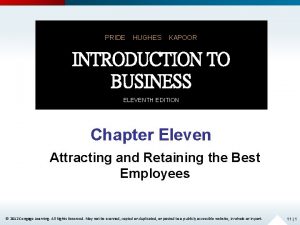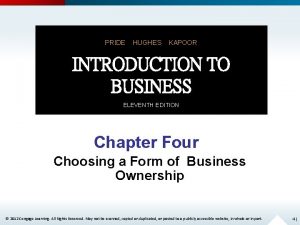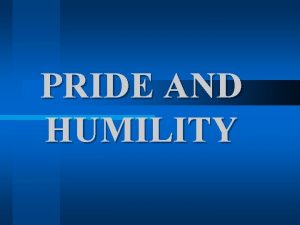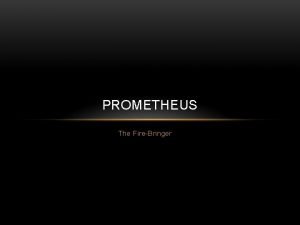Pride I Hughes I Kapoor Chapter 18 Using






















- Slides: 22

Pride I Hughes I Kapoor Chapter 18 Using Accounting Information Power. Point Presentation by Charlie Cook Copyright © by©Houghton Mifflin Company. All rights reserved. Copyright by Houghton Mifflin Company. All rights reserved. Seventh Edition

Why Accounting Information Is Important • Accounting – The process of systematically collecting, analyzing, and reporting financial information. – Accounting’s three key financial statements that summarize the firm’s activities for a specific period: • The balance sheet. • The income statement. • The statement of cash flows. • The people who use accounting information – Managers are primary users of accounting information. – Lenders require financial information before lending. – Stockholders want to know whether to invest or how well their investment is doing. – Government agencies require a variety of tax information. Copyright © by Houghton Mifflin Company. All rights reserved. 2

Users of Accounting Information The primary users of accounting information are a company’s managers, but individuals and organizations outside the company also require information on its finances. Table 18. 1 Copyright © by Houghton Mifflin Company. All rights reserved. 3

Careers in Accounting • Private Accountant – An accountant employed by a specific organization. – Services performed for the employer: • • • General accounting Budgeting Cost accounting Tax accounting Internal auditing • Public Accountant – An accountant who provides services to clients on a fee basis. • Certified Public Accountant (CPA) – An individual who has met the state requirements for accounting education and experience and has passed a rigorous two-day accounting examination. Copyright © by Houghton Mifflin Company. All rights reserved. 4

The Accounting Process • The accounting equation – Assets—the resources that a business owns (e. g. , cash, inventory, equipment, and real estate). – Liabilities—the firm’s debts that it owes to others. – Owners’ equity—what would be left if the firm’s assets were sold and the money used to pay off its liabilities. – Assets = liabilities + owners’ equity • The double-entry bookkeeping system – A system in which each financial transaction is recorded as two separate accounting entries to maintain the balance of the accounting equation. Copyright © by Houghton Mifflin Company. All rights reserved. 5

The Accounting Process (cont’d) • The accounting cycle – Analyzing source documents—analysis of documents showing day-to-day transactions to determine which accounts are affected and how they are affected. – Recording transactions—journalizing transactions in the general journal as they occur. – Posting transactions—transferring journal entries to accounts in the general ledger. – Preparing the trial balance—ascertaining the balances of all general ledger accounts at the end the accounting period. – Preparing financial statements and closing the books • Trial balance information is used to prepare the financial statements for closing an accounting period. • Post-closing trial balance is prepared. Copyright © by Houghton Mifflin Company. All rights reserved. 6

The Balance Sheet • Balance sheet (or statement of financial position) – A summary of the dollar amounts of a firm’s assets, liabilities, and owners’ equity accounts at a particular time. • Assets – Assets—the resources a business owns (e. g. , cash, inventory, equipment, and real estate). • Liquidity—the ease with which an asset can be converted into cash. – Current assets—assets that can quickly be converted to cash. • Cash, marketable securities, accounts receivable, merchandise inventory, and prepaid expenses. Copyright © by Houghton Mifflin Company. All rights reserved. 7

Personal Balance Sheet Marty Campbell Personal Balance Sheet December 31, 20 XX ASSETS Cash Savings account Automobile Stereo Television Furniture TOTAL ASSETS $ 2, 500 5, 000 1, 000 500 2, 500 LIABILITIES Automobile loan Credit card balance TOTAL LIABILITIES $ 9, 500 Even individuals can determine their net worth, or owner’s equity, by subtracting the value of their debts from the value of their assets. $26, 500 NET WORTH (Owner’s Equity) TOTAL LIABILITIES AND NET WORTH $10, 000 16, 500 $26, 500 Figure 18. 1 Copyright © by Houghton Mifflin Company. All rights reserved. 8

The Balance Sheet (cont’d) • Assets (cont’d) – Fixed assets—assets that will be held or used for a period longer than one year. • Land, buildings, and equipment. • Depreciation—the process of apportioning the cost of a fixed asset over the period during which it will be used. – Intangible assets—assets that do not exist physically but that have a value based on the rights or privileges they confer on the firm. • Patents, copyrights, trademarks, franchise rights, and goodwill. Copyright © by Houghton Mifflin Company. All rights reserved. 9

The Balance Sheet (cont’d) • Liabilities – Current liabilities—debts to be repaid within one year or less. • Accounts payable—short-term obligations that arise as a result of making credit purchases. • Notes payable—obligations that have been secured with promissory notes. – Long-term liabilities—debts that need not to be repaid for at least a year. • Mortgages, bonds, and long-term loans. • Owners’ equity – For sole proprietorships—assets less liabilities equal equity. – For partnerships—a portion of profits or liabilities based on the partner’s investment in the firm. – Retained earnings—profits not distributed to the owners. Copyright © by Houghton Mifflin Company. All rights reserved. 10

Business Balance Sheet Northeast Art Supply, Inc. Balance Sheet December 31, 20 XX ASSETS Current liabilities Accounts payable Notes payable Salaries payable Taxes payable Total current liabilities $ 59, 000 10, 000 $ 40, 000 2, 000 Notes receivable Merchandise inventory Prepaid expenses Total current assets 38, 000 32, 000 41, 000 2, 000 $182, 000 Fixed assets Delivery equipment $110, 000 Less accumulated depreciation 20, 000 Furniture and store equipment Less accumulated depreciation Total fixed assets Intangible assets Patents Goodwill Total intangible assets TOTAL ASSETS Balance Sheet December 31, 20 XX LIABILITIES AND STOCKHOLDERS’ EQUITY Current assets Cash Marketable securities Accounts receivable Less allowance for doubtful accounts Northeast Art Supply, Inc. 62, 000 15, 000 Long-term liabilities Mortgage payable on store equipment Total long-term liabilities $ 70, 000 $ 40, 000 $110, 00 TOTAL LIABILITIES $ 90, 000 47, 000 $ 35, 000 25, 675 4, 000 5, 325 137, 000 $ 6, 000 15, 000 21, 000 $340, 000 Stockholders’ equity Common stock Retailed earnings $150, 000 80, 000 TOTAL OWNERS’ EQUITY $230, 000 TOTAL LIABILITIES AND OWNERS’ EQUITY $340, 000 Assets = Liabilities + Owners’ Equity Figure 18. 2 Copyright © by Houghton Mifflin Company. All rights reserved. 11

The Income Statement • Income statement (earnings statement) – A summary of a firm’s revenues and expenses during a specified accounting period. • Profit (cash surplus) and loss (cash deficit). – Revenues—all of the dollar amounts earned by a firm from all sources (e. g. , selling goods, providing services, or performing business activities). – Gross sales—the total dollar amount of all goods and services sold during the accounting period. – Net sales—the adjusted dollar amount after subtracting sales returns, sales allowances, and sales discounts. • Cost of goods sold – Cost of goods sold—beginning inventory plus net purchases less ending inventory. Copyright © by Houghton Mifflin Company. All rights reserved. 12

The Income Statement (cont’d) • Operating expenses – All business costs other than the cost of goods sold. • Selling expenses—marketing-related activities costs • General expenses—costs for managing the business • Net income – The profit earned (or the loss suffered) by a firm during an accounting period, after all expenses have been deducted from revenues. Copyright © by Houghton Mifflin Company. All rights reserved. 13

Personal Income Statement Marty Campbell Personal Income Statement For the month ended December 31, 20 XX INCOME (Take-home pay) LESS MONTHLY EXPENSES Automobile loan Credit card payment Apartment rent Utilities Food Clothing Recreation & entertainment $1, 900 By subtracting expenses from income, you can determine if you have a surplus or deficit at the end of a specific calendar month. $ 250 100 500 250 100 250 TOTAL MONTHLY EXPENSES CASH SURPLUS (or profit) 1, 650 $ 250 Figure 18. 3 Copyright © by Houghton Mifflin Company. All rights reserved. 14

Business Income Statement For the Year Ended December 31, 20 XX Revenues Gross sales Less sales returns and allowances Less sales discounts Net sales $465, 000 $ 9, 500 4, 500 14, 000 $451, 000 Cost of goods sold Beginning inventory, January 1, 20 XX $ 40, 000 Purchases $346, 000 Less purchase discounts 11, 000 Net purchases Cost of goods available for sale 335, 000 $375, 000 Less ending inventory December 31, 20 XX Cost of goods sold Gross profit $117, 000 Gross profit Operating expenses Northeast Art Supply, Inc. Selling expenses $ 22, 000 Sales salaries 4, 000 Advertising 2, 500 Sales promotion 3, 000 Depreciation—store equipment 4, 000 Depreciation—delivery equipment 1, 500 Miscellaneous selling expenses $ 37, 000 Total selling expenses General expenses Office salaries $ 28, 500 Rent 8, 500 Depreciation—office furniture 1, 500 Utilities expense 2, 500 Insurance expense 1, 000 Miscellaneous expense 500 Total general expense 42, 500 Total operating expenses $ 79, 500 Net income from operations Less interest expense 41, 000 NET INCOME BEFORE TAXES 334, 000 $117, 000 Less federal income taxes NET INCOME AFTER TAXES $ 37, 500 2, 000 $ 35, 500 5, 325 $ 30, 175 Figure 18. 4 Copyright © by Houghton Mifflin Company. All rights reserved. 15

The Statement of Cash Flows • Statement of cash flows – A statement that illustrates how the operating, investing, and financing activities of a company affect cash during an accounting period. • Cash flows from operating activities (providing goods and services). • Cash flows from investing activities (purchase and sale of land, equipment, and other long-term assets). • Cash flows from financing activities (cash outflows for debt repayments and cash dividends). Copyright © by Houghton Mifflin Company. All rights reserved. 16

Statement of Cash Flows Northeast Art Supply, Inc. Statement of Cash Flows For the Year Ended December 31, 20 XX Cash flows from operating activities A statement of cash flows summarizes how a firm’s operating, investing, and financing activities affect its cash during a specified period— one month, three months, six months, or a year. Cash received from customers Cash paid to suppliers and employees Interest paid Income taxes paid Interest and dividends received $ 451, 000 (384, 500) ( 2, 000) ( 5, 325) 500 Net cash provided by operating activities $ 59, 675 Cash flows from investing activities Purchase of equipment Purchase of short-term investments Sale of short-term investments $( 4, 250) ( 10, 000) 11, 500 $( 2, 750) Net cash provided by investing activities Cash flows from financing activities Payment of short-term debt Payment of long-term debt Payment of dividends $( 4, 000) ( 7, 000) ( 15, 000) Net cash provided by financing activities $(26, 000) NET INCREASE (DECREASE) IN CASH $ 30, 925 Cash at beginning of year CASH AT END OF YEAR 28, 075 $ 59, 000 Figure 18. 5 Copyright © by Houghton Mifflin Company. All rights reserved. 17

Evaluating Financial Statements • Comparison of financial statements – Identify trends in growth, borrowing, and other business variables. – Determine whether the firm is on track in terms of meeting its long-term goals. • Why audited statements are important – An audit examines the company’s financial statements to make sure that they have been prepared in accordance with generally accepted accounting principles (GAAP). – Audited statements help lenders and others verify the borrower’s worth and the capability of the borrower to repay. Copyright © by Houghton Mifflin Company. All rights reserved. 18

Comparing Data for Previous Accounting Periods TOTAL DEBT NET SALES 45, 800 1997 6, 854 6, 972 6, 732 Dollars in millions 56, 154 57, 993 1998 1999 Comparison of Present and Past Financial Statements for the Boeing Corporation CAPITAL EXPENDITURES/R&D 1997 1998 3, 315* 1999 1, 924 3, 560* 1, 895 EARNINGS PER SHARE NET INCOME 1, 120 (178) 1997 1998 2. 49 Dollars in share Dollars in millions 2, 309 1999 1. 15 Dollars in millions 2, 577* 1, 341 1, 665 1, 391 1997 1, 236 1998 1999 Research and Development (. 18) 1997 1998 1999 Source: Adapted from the Boeing Corporation, 1999 Annual Report, p. 3 Copyright © by Houghton Mifflin Company. All rights reserved. Capital expenditures *Total capital expenditures/R&D Figure 18. 6 19

Financial Ratios • Financial ratio – A number that shows the relationship between two elements of a firm’s financial statements. Copyright © by Houghton Mifflin Company. All rights reserved. 20

Financial Ratios (cont’d) Copyright © by Houghton Mifflin Company. All rights reserved. 21

Financial Ratios (cont’d) Copyright © by Houghton Mifflin Company. All rights reserved. 22
 Shray kapoor
Shray kapoor Somya kapoor
Somya kapoor Define sreyas
Define sreyas Mark hughes jill hughes
Mark hughes jill hughes Pride and prejudice chapter 18 summary
Pride and prejudice chapter 18 summary Chapter 52 pride and prejudice
Chapter 52 pride and prejudice Pride and prejudice chapter 44
Pride and prejudice chapter 44 Pride and prejudice chapter 59
Pride and prejudice chapter 59 Pride and prejudice chapter 56
Pride and prejudice chapter 56 Pride and prejudice chapter 30 summary
Pride and prejudice chapter 30 summary The iron man ted hughes chapter 3
The iron man ted hughes chapter 3 Using system.collections.generic
Using system.collections.generic Unit 25 special refrigeration system components
Unit 25 special refrigeration system components Pride magazine media studies
Pride magazine media studies To serve with pride and dedication
To serve with pride and dedication Destructive pride
Destructive pride What is the function of a flower? *
What is the function of a flower? * Locations in pride and prejudice
Locations in pride and prejudice Pride youth games
Pride youth games Pride power pinstripes
Pride power pinstripes Haughty spirit before a fall
Haughty spirit before a fall Pride and prejudice volume 2
Pride and prejudice volume 2 Conclusion of prejudice
Conclusion of prejudice
